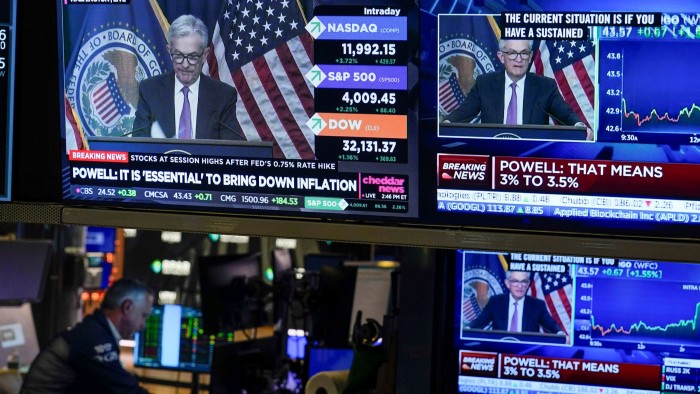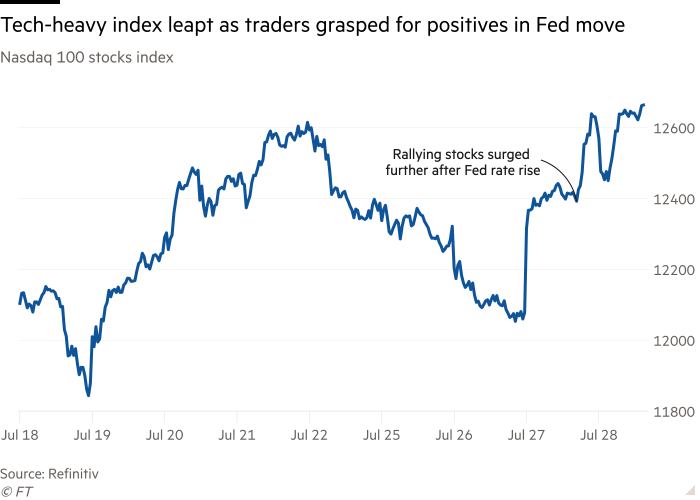Investors clutch at reasons to hope


Roula Khalaf, Editor of the FT, selects her favourite stories in this weekly newsletter.
Investors were desperate for the slightest sliver of good news from Jay Powell, and it shows.
Fund managers were pretty sure that the US Federal Reserve would raise interest rates this week at an increment that just a few months ago would have brought us all out in hives. It duly delivered a 0.75 percentage point raise — its second in a row. Those old-fashioned quarter-point steps are for wimps (and for policymakers who are not tackling inflation sailing towards double figures).
The real action, though, was always going to be in Powell’s statement and comments. He did not disappoint.
“As the stance of monetary policy tightens further, it likely will become appropriate to slow the pace of increases while we assess how our cumulative policy adjustments are affecting the economy and inflation,” the Fed chair’s statement said.
Ding ding ding! That was all the market wanted to hear. As the TikTok teens of east London might put it: “Say less, bruv.”
The Nasdaq 100 stocks index — a tech-heavy beast that has suffered greatly while the Fed has twisted the taps — put in its best performance in more than two years, up by 4 per cent by the end of the day. The benchmark S&P 500 gained 2.6 per cent.
It was all down to “a little help from the Fed”, as Julius Baer’s head of equity strategy Mathieu Racheter said. Fears of a relentlessly aggressive Fed and persistent runaway inflation have been painful for more speculative stocks this year. Now we are seeing the Fed tapping lightly on the brakes.
“The peak in inflation expectations and yields strengthens the case for growth stocks,” he said. “We anticipate a good tactical opportunity to pick up selective growth names at inexpensive valuation levels.”
The earnings season is not shaping up too badly, he added, and while analysts’ expectations for the rest of this year are likely to be still too rosy, “this phenomenon is by now well understood by the market”. In other words, the bad news is in the price already. It could finally be time to sniff around for some bargains after a grim, horrible, no-good start to 2022.
One day, this will definitely be right. Maybe that day is now. But it does require a heroic ability to screen out pretty much everything else Powell said. The words about taming rate rises cut through, but everything else was a type of white noise as when the grown-ups talk in Charlie Brown.
Over at Franklin Templeton, the tone is verging on the baffled. “Financial markets heard only what they wanted to hear and ignored the rest,” said Sonal Desai, chief investment officer for fixed income. “I think this just sets the stage for a correction, and more volatility ahead.”
Other comments in the same statement from Powell make clear that “another unusually large increase” in interest rates could still be needed at the next meeting.
“He underscored the persistent strength of the labour market and said that bringing inflation back to target will require slower growth and higher unemployment,” said Desai. “So far, markets do not seem to have paid much attention to that part.”

Markets are super-receptive to supportive news precisely because this year has been so tough so far. July’s fund manager survey from Bank of America, for example, described levels of pessimism as “dire”.
Money managers had squirrelled away the greatest share of their portfolios in cash since 9/11, according to the results of the survey announced earlier this month. The proportion of fund managers saying they are taking lower than normal levels of risk stands at 58 per cent — the highest degree of caution in the survey’s history.
Even before the Fed’s decision, market movements suggested investors were itching to see the positives in almost anything — good news; news that was somehow less terrible than they feared; or news that was so bad that it might force the Fed in to reverse.
That explains why data this week showing the second quarter of economic contraction in a row in the US left stocks in the green.
“The market has been responding like we are close to the end in synchronised volatility to the downside,” says Steven Oh, head of credit and fixed income at PineBridge Investments. “We’re operating on the basis that some bad news is good news, responding positively to the fact that we’re seeing some weakness in the economic data.”
No one wants the economy to deteriorate too badly. That is not good news for humanity (which fund managers do think about) or, more crudely, for any risky asset class. But if you are in this mindset, “you need enough weakness to get the Fed to rethink,” Oh says.
The grasping search for positive market signals of any kind could prove to be a major factor for markets over the rest of this year.
“It’s best to focus on not losing money,” says David Older, head of equities at Carmignac. But at the same time, “any breath” of good news could spark a meaningful rally from here, he says, potentially even including a peaceful outcome in Ukraine. We can hope. A relentless focus on what can go wrong has made perfect sense in 2022. But good risk management also means being ready for what can go right too.
katie.martin@ft.com
Comments